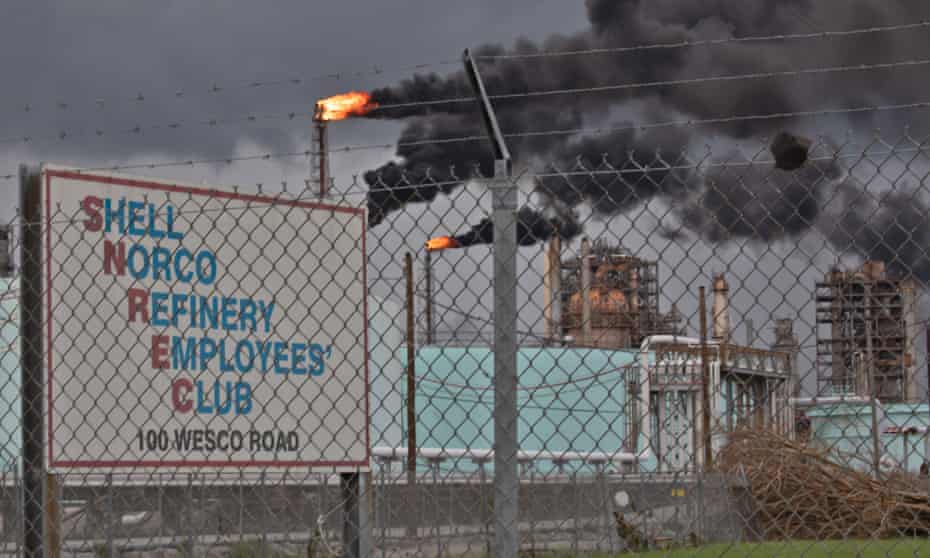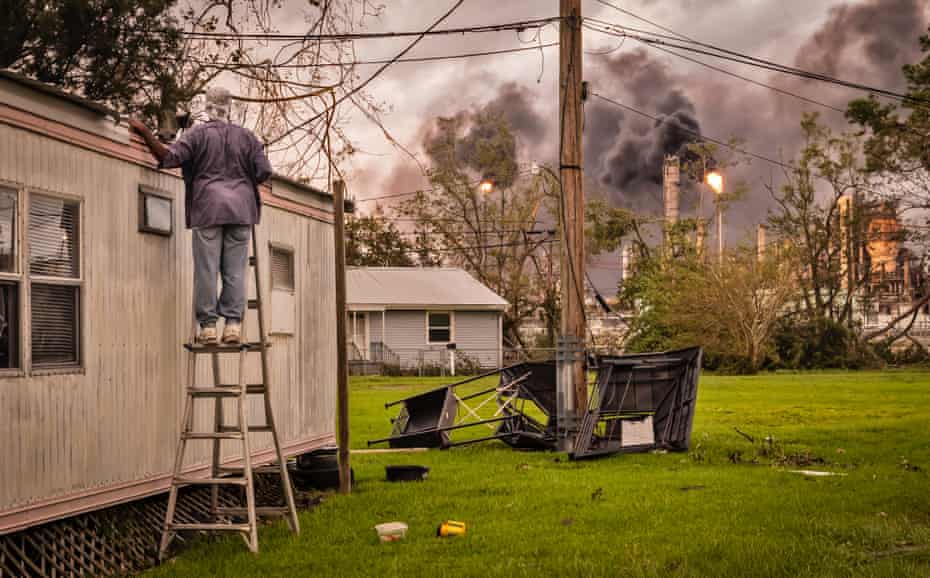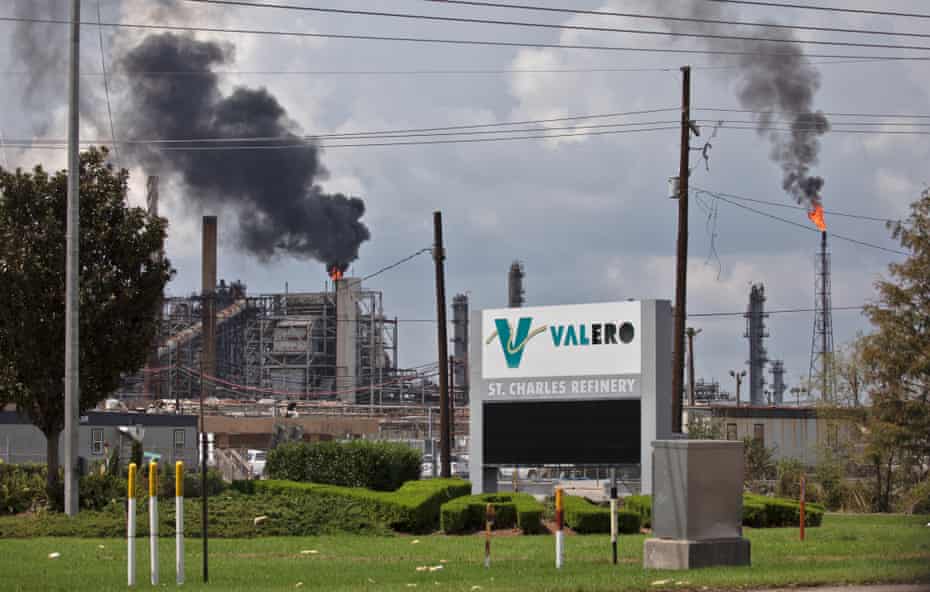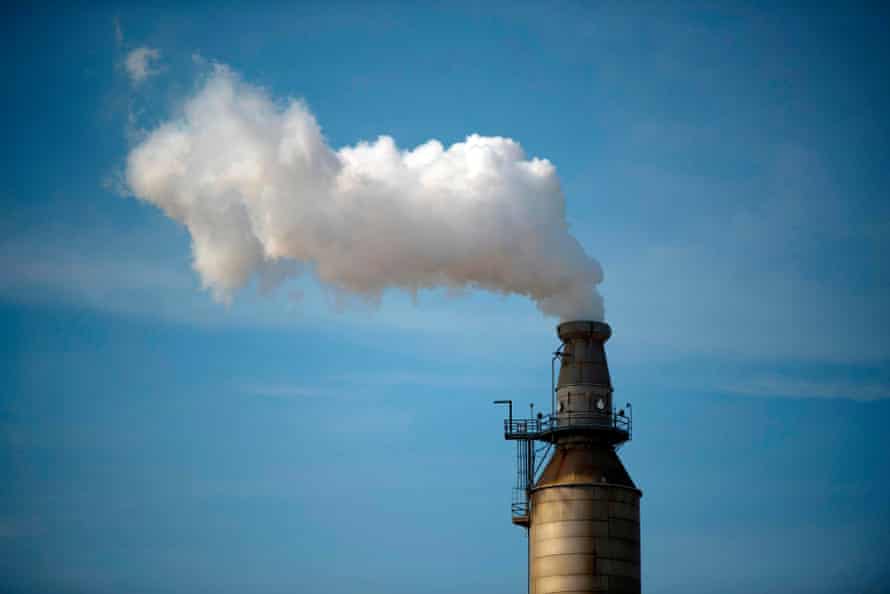Louisiana Shell refinery left spewing chemicals after Hurricane Ida



Black smoke rises from Shell’s petrochemical plant in Norco, Louisana, after Hurricane Ida knocked out the facility’s power.
Photograph: Julie Dermansky/The Guardian
Power outages from the storm have left air quality tracking systems out of commission, making public health concern hard to gauge
Sara Sneath in Norco, Louisiana
Sat 4 Sep 2021 11.00 BST
Behind a playground littered with downed tree branches, Shell’s refinery in Norco, Louisiana spewed black smoke from its stacks. The smell of rotten eggs, the signature scent of sulphur emissions, lingered in the air. In an effort to burn off toxic chemicals before and after Hurricane Ida, many industrial facilities sent the gases through smoke stacks topped with flares.
But the hurricane blew out some of those flares like candles, allowing harmful pollution into the air.
Health concerns linked to potential toxic exposure underscore the array of long-term impacts brought by the category 4 storm that struck south-east Louisiana earlier this week. As of Thursday afternoon, nearly a million homes and businesses were without power, leaving hundreds of thousands more without access to clean water. And with hundreds of chemical facilities located within the path of the hurricane, numerous air quality tracking systems were left out of commission. It’s unclear how long it will take to assess the full scope of the damage and its toll on residents.
The degree of the pollution is still unknown in part because phone lines have been down in portions of the state, including the hotline for the Louisiana state police, which has deployed its hazardous materials unit to handle toxic emissions from industrial facilities in the past, according to an Environmental Protection Agency report. So far, the US Coast Guard has received 17 calls about air releases to the National Response Center, including multiple reports of ammonia released into the air because flares were blown out by the storm.

Power outages from the storm have left air quality tracking systems out of commission, making public health concern hard to gauge
Sara Sneath in Norco, Louisiana
Sat 4 Sep 2021 11.00 BST
Behind a playground littered with downed tree branches, Shell’s refinery in Norco, Louisiana spewed black smoke from its stacks. The smell of rotten eggs, the signature scent of sulphur emissions, lingered in the air. In an effort to burn off toxic chemicals before and after Hurricane Ida, many industrial facilities sent the gases through smoke stacks topped with flares.
But the hurricane blew out some of those flares like candles, allowing harmful pollution into the air.
Health concerns linked to potential toxic exposure underscore the array of long-term impacts brought by the category 4 storm that struck south-east Louisiana earlier this week. As of Thursday afternoon, nearly a million homes and businesses were without power, leaving hundreds of thousands more without access to clean water. And with hundreds of chemical facilities located within the path of the hurricane, numerous air quality tracking systems were left out of commission. It’s unclear how long it will take to assess the full scope of the damage and its toll on residents.
The degree of the pollution is still unknown in part because phone lines have been down in portions of the state, including the hotline for the Louisiana state police, which has deployed its hazardous materials unit to handle toxic emissions from industrial facilities in the past, according to an Environmental Protection Agency report. So far, the US Coast Guard has received 17 calls about air releases to the National Response Center, including multiple reports of ammonia released into the air because flares were blown out by the storm.

Peter Anderson walks his rescue dogs, Phoebe and Joe, near the Shell Norco manufacturing complex.
Photograph: Julie Dermansky/The Guardian
About 50% of the US petroleum refining capacity and 51% of the US natural gas processing capacity are based along the Gulf of Mexico, according to the US Energy Information Administration. The industrial facilities have become an added hazard when hurricanes come ashore. In a matter of just a few days after Hurricane Harvey made landfall in 2017, air pollution levels added up to 39% of the total unauthorized emissions of the previous year in the Houston area, said Luke Metzger, the executive director for Environment Texas.
“These emissions absolutely can be big enough to contribute to health problems,” he said.
The degree of the public health concern is harder to gauge in Louisiana, where air monitoring efforts are often slow to capture peak emission levels directly after a storm, when facilities are likely to belch pollution. After Hurricane Laura came ashore near the border of Texas and Louisiana in August last year, the Texas Commission on Environmental Quality sent out a mobile air monitoring van to detect air pollution in the state within 15 hours. It was days before Louisiana’s Department of Environmental Quality did the same.
Four days after Hurricane Ida, there was still no data posted to the state agency’s website from its mobile air monitors. A state mobile air monitoring lab was expected to deploy Thursday to Norco, about 20 miles (32 km) north-west of New Orleans, according to an EPA report. The Shell refinery there has indicated it will continue flaring until electricity is restored to its facility, said Wilma Subra, an environmental scientist with the Louisiana Environmental Action Network organization who was awarded the MacArthur grant for her work helping residents to understand the public health risks of industrial pollution.
But the refinery’s lack of electricity and inability to supply steam and nitrogen to the flares means chemicals are not being burned off properly, causing thick black smoke to pour into the sky above residents who are repairing their damaged roofs and cutting broken branches from trees.
“Community members in Norco have a right to know what chemicals are in the air they are breathing,” Subra said.
About 50% of the US petroleum refining capacity and 51% of the US natural gas processing capacity are based along the Gulf of Mexico, according to the US Energy Information Administration. The industrial facilities have become an added hazard when hurricanes come ashore. In a matter of just a few days after Hurricane Harvey made landfall in 2017, air pollution levels added up to 39% of the total unauthorized emissions of the previous year in the Houston area, said Luke Metzger, the executive director for Environment Texas.
“These emissions absolutely can be big enough to contribute to health problems,” he said.
The degree of the public health concern is harder to gauge in Louisiana, where air monitoring efforts are often slow to capture peak emission levels directly after a storm, when facilities are likely to belch pollution. After Hurricane Laura came ashore near the border of Texas and Louisiana in August last year, the Texas Commission on Environmental Quality sent out a mobile air monitoring van to detect air pollution in the state within 15 hours. It was days before Louisiana’s Department of Environmental Quality did the same.
Four days after Hurricane Ida, there was still no data posted to the state agency’s website from its mobile air monitors. A state mobile air monitoring lab was expected to deploy Thursday to Norco, about 20 miles (32 km) north-west of New Orleans, according to an EPA report. The Shell refinery there has indicated it will continue flaring until electricity is restored to its facility, said Wilma Subra, an environmental scientist with the Louisiana Environmental Action Network organization who was awarded the MacArthur grant for her work helping residents to understand the public health risks of industrial pollution.
But the refinery’s lack of electricity and inability to supply steam and nitrogen to the flares means chemicals are not being burned off properly, causing thick black smoke to pour into the sky above residents who are repairing their damaged roofs and cutting broken branches from trees.
“Community members in Norco have a right to know what chemicals are in the air they are breathing,” Subra said.

A resident inspects the damage to his home next to Shell’s refinery and chemical plant on 31 August.
Photograph: Julie Dermansky/The Guardian
Shell is still assessing the impact of Hurricane Ida on the Norco refinery and another refinery in Geismar, Louisiana, said Curtis Smith, a company spokesman. Essential personnel are staffing the facilities, but it’s too early to know when they will resume full operations, he added.
“While the site remains safe and secure, we are experiencing elevated flaring. We expect this to continue until power is restored,” Smith said. Smith did not respond to a question about whether neighbors should be concerned that their health could be impacted by the emissions.
A state air monitor in Norco stopped collecting data on the day of the storm. It’s among 17 state air monitoring sites that stopped working due to power outages, according to an EPA report. The Valero refinery in Saint Bernard Parish notified the EPA that it shutdown its community air monitoring station to protect the equipment. The company was required to notify the federal agency because of past violations of the Clean Air Act at the refinery under its previous owner, Murphy Oil. During Hurricane Katrina, the refinery’s tank farm flooded, leaking more than a million gallons of crude oil into 1,800 homes, according to the EPA.
It’s unclear how quickly Valero is required to get the air monitor back in operation. That’s because it’s owned by the company, not the state, said Greg Langley, a spokesman for the Louisiana Department of Environmental Quality. “We get readings submissions, but the monitor is not part of our reporting system,” he said. “LDEQ does not dictate when it is turned on and turned off.” After Hurricane Laura came ashore in the Lake Charles region, air monitors in the area were out from one to four weeks.

Shell is still assessing the impact of Hurricane Ida on the Norco refinery and another refinery in Geismar, Louisiana, said Curtis Smith, a company spokesman. Essential personnel are staffing the facilities, but it’s too early to know when they will resume full operations, he added.
“While the site remains safe and secure, we are experiencing elevated flaring. We expect this to continue until power is restored,” Smith said. Smith did not respond to a question about whether neighbors should be concerned that their health could be impacted by the emissions.
A state air monitor in Norco stopped collecting data on the day of the storm. It’s among 17 state air monitoring sites that stopped working due to power outages, according to an EPA report. The Valero refinery in Saint Bernard Parish notified the EPA that it shutdown its community air monitoring station to protect the equipment. The company was required to notify the federal agency because of past violations of the Clean Air Act at the refinery under its previous owner, Murphy Oil. During Hurricane Katrina, the refinery’s tank farm flooded, leaking more than a million gallons of crude oil into 1,800 homes, according to the EPA.
It’s unclear how quickly Valero is required to get the air monitor back in operation. That’s because it’s owned by the company, not the state, said Greg Langley, a spokesman for the Louisiana Department of Environmental Quality. “We get readings submissions, but the monitor is not part of our reporting system,” he said. “LDEQ does not dictate when it is turned on and turned off.” After Hurricane Laura came ashore in the Lake Charles region, air monitors in the area were out from one to four weeks.

Smoke billows out from the Valero Saint Charles refinery in Norco.
Photograph: Julie Dermansky/The Guardian
In addition to the public health risks posed by hazardous air pollution and oil and gas spills during hurricanes, fossil fuel companies have also damaged Louisiana’s natural storm defense system. Some of the oil and gas processed in industrial facilities were pulled from the state’s marshlands. To develop wells, companies cut thousands of miles of canals through the wetlands. The canals allow saltwater to creep into the root systems of freshwater marsh plants, killing and sinking wetlands.
Louisiana has lost 2,000 sq miles (5,000 sq km) of land since the 1930s. It’s estimated that about a third of that wetland loss is from oil and gas development, said Alex Kolker, a coastal scientist who serves on the science advisory group for the state’s Climate Initiatives Task Force. Without these wetlands, coastal communities are more vulnerable to storm surge and flooding.
Hurricanes themselves also rip up wetlands and storms intensified by climate change are likely to do more damage. This creates a positive feedback loop, where wetlands ripped up by hurricanes make communities more vulnerable to the next hurricane, Kolker said.
Louisiana governor John Bel Edwards created the state’s Climate Initiatives Task Force with the goal of reducing greenhouse gas emissions in the state to net zero by 2050. The majority of carbon emissions in the state – about 49% – are from the industrial sector. But the state’s reduction goals aren’t aimed at toxic emissions, the bigger concern following storms.
“When I think about releases from a storm like this, I’m more concerned about toxic releases than I am about greenhouse gas emissions,” Kolker said.
This story is published as part of Covering Climate Now, a global collaboration of news outlets strengthening coverage of the climate story.
In addition to the public health risks posed by hazardous air pollution and oil and gas spills during hurricanes, fossil fuel companies have also damaged Louisiana’s natural storm defense system. Some of the oil and gas processed in industrial facilities were pulled from the state’s marshlands. To develop wells, companies cut thousands of miles of canals through the wetlands. The canals allow saltwater to creep into the root systems of freshwater marsh plants, killing and sinking wetlands.
Louisiana has lost 2,000 sq miles (5,000 sq km) of land since the 1930s. It’s estimated that about a third of that wetland loss is from oil and gas development, said Alex Kolker, a coastal scientist who serves on the science advisory group for the state’s Climate Initiatives Task Force. Without these wetlands, coastal communities are more vulnerable to storm surge and flooding.
Hurricanes themselves also rip up wetlands and storms intensified by climate change are likely to do more damage. This creates a positive feedback loop, where wetlands ripped up by hurricanes make communities more vulnerable to the next hurricane, Kolker said.
Louisiana governor John Bel Edwards created the state’s Climate Initiatives Task Force with the goal of reducing greenhouse gas emissions in the state to net zero by 2050. The majority of carbon emissions in the state – about 49% – are from the industrial sector. But the state’s reduction goals aren’t aimed at toxic emissions, the bigger concern following storms.
“When I think about releases from a storm like this, I’m more concerned about toxic releases than I am about greenhouse gas emissions,” Kolker said.
This story is published as part of Covering Climate Now, a global collaboration of news outlets strengthening coverage of the climate story.
Exxon slammed as climate hypocrites for sending ‘thoughts and prayers’ to Ida victims
Critics pillory big oil companies for cynical expressions of sympathy while continuing to block climate solutions

Ahead of the latest Intergovernmental Panel on Climate Change report released earlier this month, and its dire warning that global heating will probably reach 1.5C within the next two decades, oil companies filled their feeds with renewable energy pledges, claims of green accomplishments and sustainability buzzwords.
The average social media user perusing BP’s tweets on solar energy just days before the report’s release might have been surprised to learn that the “P” in the company’s name once stood for petroleum, and that even in a decade’s time its investments in renewable energy are expected to amount to less than half of its total capital investments today.
Offering “thoughts and prayers” on social media in response to tragedy is now commonly associated with reactions to US gun violence – and is considered by some activists to be a pale substitute for concrete action. Exxon is currently facing lawsuits that allege “deceptive marketing” and “greenwashing” – the practice of marketing a company or a product as environmentally friendly to hide a true record of fossil fuel emissions and polluting.
Fossil fuel facilities are in fact vulnerable to extreme weather. When millions of Texans were left freezing after a severe winter storm and power outage earlier this year, fossil fuel energy-generating stations were knocked offline and oil refineries, chemical manufacturers and other industrial plants in the state emitted about 3.5m pounds of excess pollutants into the air.
Oil and gas regulators nevertheless rushed to defend the industry’s image of “reliability”, according to Texas Tribune, instead blaming wind power, which accounts for less than 24% of the state’s energy, and the progressive left for the power outages.
Critics pillory big oil companies for cynical expressions of sympathy while continuing to block climate solutions

Oil companies’ expressions of sympathy in the wake of Hurricane Ida have been an object of ridicule.
Photograph: Mark Felix/AFP via Getty Images
Supported by
.png)
Aliya Uteuova
Fri 3 Sep 2021
Major oil companies are being pilloried on social media for sending “thoughts and prayers” to victims of Hurricane Ida while sidestepping their role in the ongoing climate disaster.
At least two ExxonMobil outposts – from Beaumont and Baytown, Texas – tweeted the message on Monday, using the hashtag #LouisianaStrong. It didn’t take long for Twitter users to call out the company for its tone-deaf response, noting that Exxon’s own internal research program predicted catastrophic climate change decades ago.
Moreover, in the last 80 years, Louisiana has lost roughly 2,000 square miles of its coastal wetlands, according to the US Geological Survey. The major factors contributing to the decline of the natural storm barrier are offshore oil rigs, onshore wells and refineries operating on the shoreline.
The death toll from Hurricane Ida is now nearing 50, after the storm tore a path through the south, mid-Atlantic and north-eastern US.
This is not the first time the fossil fuel industry has been rebuked for sending “thoughts and prayers” in the wake of disasters exacerbated by climate change. For years, as the climate crisis has intensified, oil companies have extended social media messages of sympathy without addressing climate change and the role of fossil fuel emissions as the root of the problem.
Chevron’s Houston account extended its “thoughts” in the midst of a deadly category 4 Hurricane Laura last August. In 2017 during Hurricane Harvey, Exxon encouraged Texas and Louisiana to “stay strong”. Scientists say that both disasters were intensified by the impacts of a changing climate.
Supported by
.png)
Aliya Uteuova
Fri 3 Sep 2021
Major oil companies are being pilloried on social media for sending “thoughts and prayers” to victims of Hurricane Ida while sidestepping their role in the ongoing climate disaster.
At least two ExxonMobil outposts – from Beaumont and Baytown, Texas – tweeted the message on Monday, using the hashtag #LouisianaStrong. It didn’t take long for Twitter users to call out the company for its tone-deaf response, noting that Exxon’s own internal research program predicted catastrophic climate change decades ago.
Moreover, in the last 80 years, Louisiana has lost roughly 2,000 square miles of its coastal wetlands, according to the US Geological Survey. The major factors contributing to the decline of the natural storm barrier are offshore oil rigs, onshore wells and refineries operating on the shoreline.
The death toll from Hurricane Ida is now nearing 50, after the storm tore a path through the south, mid-Atlantic and north-eastern US.
This is not the first time the fossil fuel industry has been rebuked for sending “thoughts and prayers” in the wake of disasters exacerbated by climate change. For years, as the climate crisis has intensified, oil companies have extended social media messages of sympathy without addressing climate change and the role of fossil fuel emissions as the root of the problem.
Chevron’s Houston account extended its “thoughts” in the midst of a deadly category 4 Hurricane Laura last August. In 2017 during Hurricane Harvey, Exxon encouraged Texas and Louisiana to “stay strong”. Scientists say that both disasters were intensified by the impacts of a changing climate.
Ahead of the latest Intergovernmental Panel on Climate Change report released earlier this month, and its dire warning that global heating will probably reach 1.5C within the next two decades, oil companies filled their feeds with renewable energy pledges, claims of green accomplishments and sustainability buzzwords.
The average social media user perusing BP’s tweets on solar energy just days before the report’s release might have been surprised to learn that the “P” in the company’s name once stood for petroleum, and that even in a decade’s time its investments in renewable energy are expected to amount to less than half of its total capital investments today.
Offering “thoughts and prayers” on social media in response to tragedy is now commonly associated with reactions to US gun violence – and is considered by some activists to be a pale substitute for concrete action. Exxon is currently facing lawsuits that allege “deceptive marketing” and “greenwashing” – the practice of marketing a company or a product as environmentally friendly to hide a true record of fossil fuel emissions and polluting.
Fossil fuel facilities are in fact vulnerable to extreme weather. When millions of Texans were left freezing after a severe winter storm and power outage earlier this year, fossil fuel energy-generating stations were knocked offline and oil refineries, chemical manufacturers and other industrial plants in the state emitted about 3.5m pounds of excess pollutants into the air.
Oil and gas regulators nevertheless rushed to defend the industry’s image of “reliability”, according to Texas Tribune, instead blaming wind power, which accounts for less than 24% of the state’s energy, and the progressive left for the power outages.
No comments:
Post a Comment